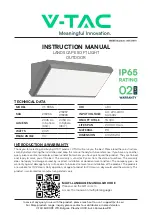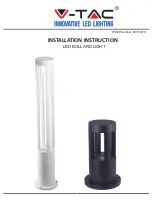
1942518
V1.0
30 November 2021
Instruction Sheet Template - V1.1 – Updated 23/11/2020
Installation:
•
Remove the four (4) screws holding the diffuser to the base.
•
Remove the four (4) screws holding the gear tray to the base.
•
Determine the cable access point. There are 2 locations on opposite sides of the fitting for cable
gland/conduit entry. Entry can also be from the back of the base. Drill out the desired cable entry
point.
Note: Only round cables are to be used with the cable gland for an IP65 seal. Keep cable entry
straight and tension free. Ensure all seals are tight.
min. wire diameter 7mm, max. 12mm.
•
Drill out 4 of the mounting points in the base (see image below).
•
Using the base as a guide, mark the 4 holes for mounting and one for mains access if using back
cable entry.
•
Mount the base using appropriate fixings and seal these fixings with appropriate sealant (also fill any
additional entry points).
•
If Wall Mounted
, then the installation should take place in a manner such that the Status LED is at
the bottom where it will be visible to an observer standing directly below the luminaire.
•
Route the power inside the base.
•
Connect the 240VAC (
, Lsw,,Lem, N) supply to the terminal block of the gear tray.
•
Install the gear tray to the base.
•
Apply power to the fitting and test per the instructions.
If the CTP capabilities are activated, please affix the CTP status label to a visible surface and Four
Segment Marking on the product will include an ‘’F’’ in third segment block
Dimensions:
Driver Setting:
For non -SEN / -DD products
Testing:
When the unit is connected to the un-switched active, it must be allowed to charge the battery for at
least 24 hours. The emergency lamp only illuminates during a power fail. Conduct the following tests:
•
The emergency lamp must illuminate for at least 180 min after disconnection from the mains. If the
unit fails to illuminate for the requisite time, remedial action must be taken to repair the situation
and once completed, the unit must pass a subsequent test.
•
Press and hold Test Button or switch Off Mains Supply, check that the emergency lamp is On.
•
Release the Test Button or Switch On Mains Supply, check that the emergency lamp is Off (Non-
maintained operation).
Battery Replacement:
1. Prior to any work, isolate the power to the luminaire that requires battery replacement
2. Open the fitting by removing the securing screws holding the diffuser, support diffuser doing this.
3. Remove gear tray by removing screws, support gear tray during this process.
4. Remove the Battery Connector from the Emergency Driver.
5. Remove the battery from the gear tray by removing mounting screws.
6. Replace battery, re-install screws and connect to Emergency Driver.
7. Reinstall the Gear Tray.
8. Refit the diffuser, ensure diffuser is aligned to maintain the weatherproof seal.
Lamp Replacement:
1. Prior to any work, isolate the power to the luminaire that requires lamp replacement
2. Use only the lamp(s) recommended on the label inside the Argonaut.
3. Open the fitting by removing the securing screws holding the diffuser, support diffuser doing this.
4. Remove gear tray by removing screws, support gear tray during this process.
5. To replace the LED Panel, remove the clips, disconnect the signal cable and install the new Lamp
Panel.
6. Reinstall the Gear Tray.
7. Refit the diffuser, ensure diffuser is aligned to maintain the weatherproof seal.
Trouble Shooting:
Below are a list of common problems and their possible causes.
Fault: The Green LED Test Switch indicator is not illuminated.
Check: A.C. is connected and is turned on.
Battery is connected
Test Switch for damage.
Fault: Lamp does not illuminate in emergency mode.
Check: A.C. is connected.
Lamp is correctly inserted.
Battery is connected
Fault: Lamp illuminates in emergency mode, but only stays on for a short period.
Check: Battery has been allowed to charge for at least 24 hours.
Battery for damage.
Caution:
On many building sites, power circuits may be cut off in an uncontrolled and repetitive basis during
construction. As a result, any Exit & Emergency Units, on these circuits, will have their batteries
discharged or “cycled”. The Li-ion battery in the Exit & Emergency Unit has been selected to give
excellent long life performance in a controlled IEC 60598-2-22 testing environment. Excessive battery
cycling will reduce through-life performance and may lead to premature battery failure. Battery warranty
claims, as a result of such abuse, are specifically EXCLUDED from Clevertronics warranty terms.
Warranty:
For Product Warranty information and Terms and Conditions of Sales please refer to our website
https://clevertronics.co.uk/product-warranty-statement/




















